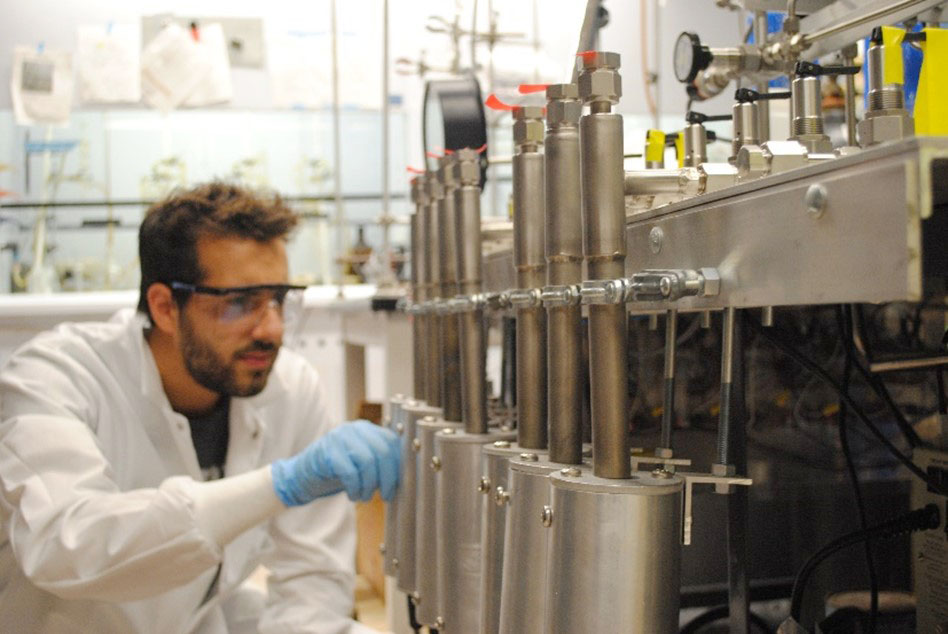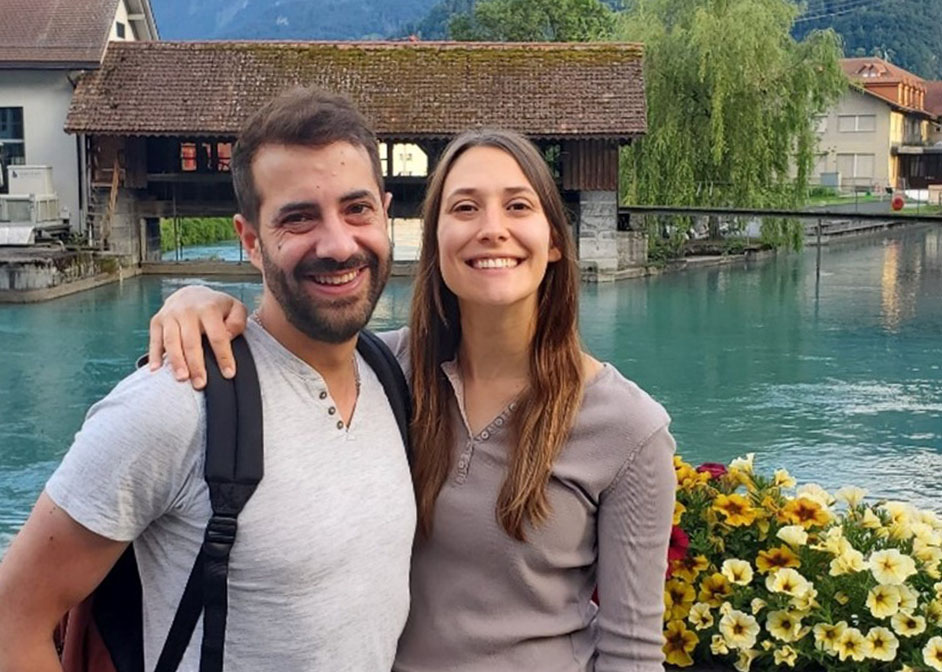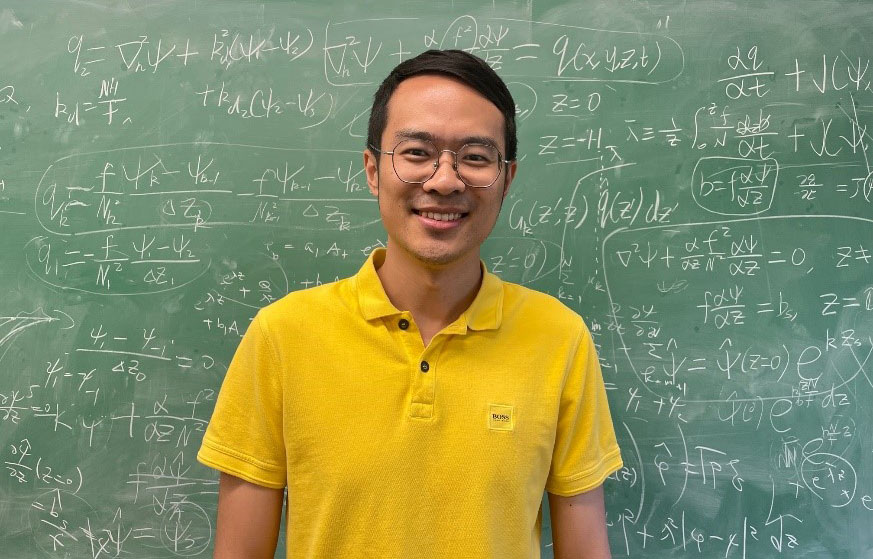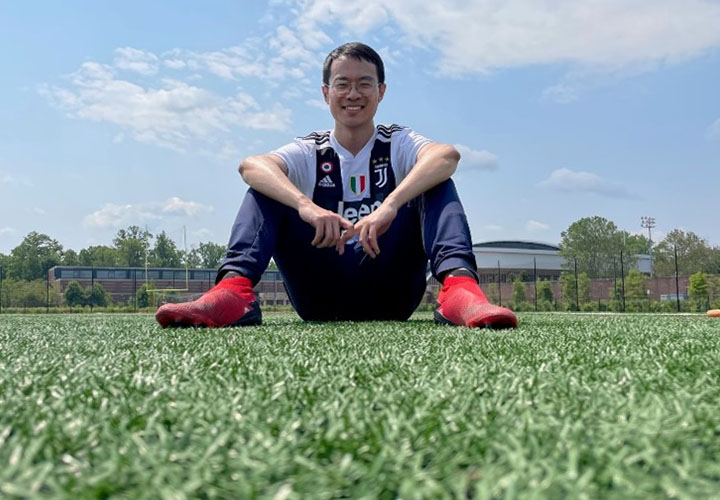Staff and Faculty Update, Introducing New EAS Faculty

The EAS Staff
Our staff dressed in their finest pink attire to support Breast Cancer Awareness Month in October. Front row, left to right: Summer Crawley, Mariam El Boubou, Keshia Groggs, Marsha Braxton, Mariela Raudales, Keah Walker, Antonius Douglas, and Eddie Gonzalez. Back row, left to right: Jay Krishnan, Jason Ognosky, Katrina Smith, Jasmine Brumfield, and Jim Parker.
Meet the New EAS Faculty
- Michael Antonelli, Ph.D., Assistant Professor, Isotope Geochemistry
- Youtong Zheng, Ph.D., Assistant Professor, Atmospheric and Climate Physics
Michael Antonelli, Ph.D., Assistant Professor, Isotope Geochemistry
Dr. Antonelli is a geochemist with expertise in using mid-mass stable isotopes to address fundamental questions in Earth science. His approach combines disequilibrium principles and analyses of non-traditional stable and radiogenic isotope systems with geochemical models and traditional petrographic techniques. The overarching goal of his research is to constrain the reaction rates, timescales, mechanisms, and sources of important rock-forming processes to better understand the solid Earth and its interactions with the hydrosphere, atmosphere, and biosphere through geologic time.
 Specifically, Antonelli has had a pioneering role in the application and interpretation of radiogenic and stable calcium isotope variations in igneous and metamorphic systems. Although his recent work has begun to explore deep mantle processes and the deep carbon cycle (which is intimately linked to the Ca cycle), much of his past work has concentrated on relatively shallower topics, such as volcanic processes and the formation and evolution of Earth’s continental crust.
Specifically, Antonelli has had a pioneering role in the application and interpretation of radiogenic and stable calcium isotope variations in igneous and metamorphic systems. Although his recent work has begun to explore deep mantle processes and the deep carbon cycle (which is intimately linked to the Ca cycle), much of his past work has concentrated on relatively shallower topics, such as volcanic processes and the formation and evolution of Earth’s continental crust.
Some of the principal questions that drive his research are:
- What are the characteristics and fluxes of surface materials (e.g., carbonate sediments and altered oceanic crust) that are recycled into the deep Earth at modern and ancient subduction zones, and how can contributions from these materials be identified in mantle-derived magmas to better understand the deep Earth carbon cycle?
- What are the processes and timescales associated with metamorphism, magma formation, magma chamber recharge, volcanic eruptions, and with the formation of continental crust, and how have these evolved over Earth history?
- What are the mechanisms that govern stable isotope fractionation in high and low temperature systems, and how can we disentangle source-based from process-based isotopic variations (such as those induced by diffusion, reaction, and equilibration) in nature?
 Given that the same fundamental isotopic principles apply across all natural systems, Antonelli has also applied his expertise across a wide range of fields and is highly interested in marine geochemistry, low-temperature mineral formation (e.g., carbonates, biocalcification), paleoclimate, hydrothermal systems/ore deposits, solar system and planetary evolution, biology, and (paleo)ecology.
Given that the same fundamental isotopic principles apply across all natural systems, Antonelli has also applied his expertise across a wide range of fields and is highly interested in marine geochemistry, low-temperature mineral formation (e.g., carbonates, biocalcification), paleoclimate, hydrothermal systems/ore deposits, solar system and planetary evolution, biology, and (paleo)ecology.
In his spare time, he is an avid musician/music-producer and likes to listen to and produce music, play the drums, travel (mostly for the food), hike (mostly for the picnic), and watch classic films.
Youtong Zheng, Ph.D., Assistant Professor, Atmospheric and Climate Physics
Dr. Zheng is an atmospheric scientist who studies cloud formation and turbulence and their roles in weather, climate, and climate change. He uses a hierarchy of approaches ranging from pencil-and-paper theory to comprehensive computer models to satellite and experimental observations.
 A cornerstone of his work is an emphasis on developing physical intuition using theory and idealized models. He then uses the intuition to understand more complex phenomena in observations and comprehensive climate models and applies the improved understanding to address practical issues of societal importance.
A cornerstone of his work is an emphasis on developing physical intuition using theory and idealized models. He then uses the intuition to understand more complex phenomena in observations and comprehensive climate models and applies the improved understanding to address practical issues of societal importance.
 Recently, he was awarded the Department of Energy (DOE) Early Career Award, directing his focus toward investigating the impacts of air pollution on coastal storms. This project aims to address an actively debated question: Can human-generated air pollution make coastal storms more intense? Utilizing the DOE’s advanced kilometer-scale climate model, the Simple Cloud-Resolving E3SM Atmosphere Model (SCREAM), this research endeavors to improve the predictability of coastal-urban systems under the dual impact of air pollution and coastal storms.
Recently, he was awarded the Department of Energy (DOE) Early Career Award, directing his focus toward investigating the impacts of air pollution on coastal storms. This project aims to address an actively debated question: Can human-generated air pollution make coastal storms more intense? Utilizing the DOE’s advanced kilometer-scale climate model, the Simple Cloud-Resolving E3SM Atmosphere Model (SCREAM), this research endeavors to improve the predictability of coastal-urban systems under the dual impact of air pollution and coastal storms.
In his free time, he enjoys a range of sports like soccer, MMA, basketball, swimming, and table tennis, though he humorously admits his skills are more theoretical than practical. His unique twist on sports viewing involves a hot tub and a favorite drink. Beyond sports, he likes reading literature and psychology.
